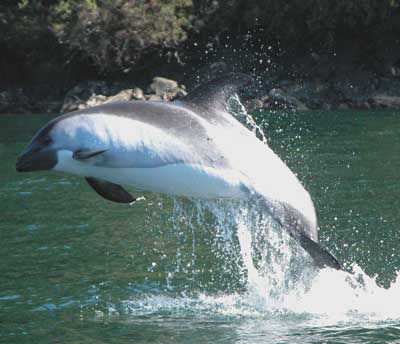Peale's dolphin - Lagenorhynchus australis
Taxonomy & Nomenclature
Physical Description / Field Identification
The general body shape is typical for dolphins of the genus Lagenorhynchus. Few specimens have been examined, but observations of Peale’s dolphins suggest they are the most robust of the Southern Hemisphere dolphins of this genus. The dorsal fin is pointed and falcate.
Peale’s dolphins share coloration pattern components with both dusky and Pacific white-sided dolphins. Peale’s dolphins are grayish black above and white below. They have a curved flank patch of light gray with a single dorsal spinal blaze, or "suspender," fading into the black of the back near the blowhole. A large pale gray thoracic patch extends from the eye to mid-body; it is separated from the white below by a well-developed dark stripe. The stripe loops up above a small white patch under the flipper. The flippers are gray-black, and the dorsal fin is dark gray-black, with a thin crescent of light gray on the trailing margin. Tooth counts for four specimens were 29-33 on each side of each jaw.
Only a few dozen specimens have been measured. The largest specimen recorded was 2.18 m long, and an adult female weighed 115 kg. Length at birth is estimated to be about 1 m. Can be Confused With
Peale’s dolphins are most easily confused with dusky dolphins. The face, rostrum, melon and most of the chin of Peale’s dolphins are dark gray-black, as if encased in a mask. This feature, plus the well-developed black stripe below the thoracic patch, readily distinguishes Peale’s dolphins from dusky dolphins. Distribution
Peale’s dolphins are confined to South America, from the southern tip to about the latitudes of Santiago, Chile (33°S), and northern Argentina (38°S). They are regularly seen around the Falkland Islands. Peale’s dolphins are coastal animals, found in bays and inlets, around islands, and over the continental shelf. They are frequently seen close to shore, even shoreward of kelp beds.
One exceptional sighting of what was thought to be this species was reported from Palmerston Atoll. However, several other sightings of Lagenorhynchus-like dolphins in tropical/subtropical waters of the Indo-Pacific have since surfaced. This brings up the possibility of an undecribed species in this area. Ecology and Behavior
Peale’s dolphins have been seen in small groups (5-30 are typical). They frequently bowride, and will sprint to a ship’s bow. At the bow, they often speed ahead, leap high into the air and fall back into the water on their sides, producing a large splash with a loud slapping noise. They are often seen in and around kelp beds, especially in the Falkland Islands. Feeding and Prey
Little is know of food and feeding habits. The few stomachs that have been examined contained demersal fish, octopus, and squid species that occur in shallow waters and in kelp beds. Threats and Status
Peale’s dolphins have been killed for crab bait in both Chile and Argentina. At times, this exploitation was significant enough to consider the species at risk of local extripation. Currently, it is listed as “Data Deficient” (IUCN) and “Not Listed” (ESA). Links
References
Brownell, Jr., R.L., J.E.A. Crespo, and M.A. Donahue. 1999. Peale’s dolphin Lagenorhynchus australis (Peale, 1848). pp. 105-120 in S.H. Ridgway and R. Harrison, eds. Handbook of Marine Mammals, Vol. 6: The second book of dolphins and the porpoises. Academic Press.
Goodall, R.N.P. 2002. Peale’s dolphin Lagenorhynchus autralis. pp. 890-894 in W.F. Perrin, B. Würsig and J.G.M. Thewissen, eds. Encyclopedia of Marine Mammals. Academic Press.
Goodall, R.N.P., K.S. Norris, W.E. Schevill, F. Fraga, R. Praderi, M.A. Iniguez, Jr. and J.C. de Haro. 1997. Review and update on the biology of Peale’s dolphin, Lagenorhynchus australis. Report of the International Whaling Commission 47:777-796.
Lescrauwaet, A.K. 1997. Notes on the behaviour and ecology of the Peale’s dolphin, Lagenorhynchus australis, in the Strait of Magellan, Chile. Reports of the International Whaling Commission 47:747-756.
Van Waerebeek, K., R.N.P. Goodall, P.B. Best. 1997. A note on evidence for pelagic warm-water dolphins resembling Lagenorhynchus. Reports of the International Whaling Commission 47:1015-1017.
|
|

| ITIS TSN | 180446 |
|
Status - ESA, U.S. FWS
|
| - |
|
Status - Red List, IUCN
|
| LC (Global) |
| #records (spatial) | 170 |
| #records (non-spatial) | 2 |
| #datasets | 5 |
| Year | 1998 - 2025 |
| Latitude | -56.24 - -40.13 |
| Longitude | -74.17 - -56.02 |
| See metadata in static HTML |
|

